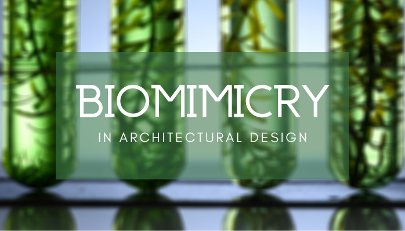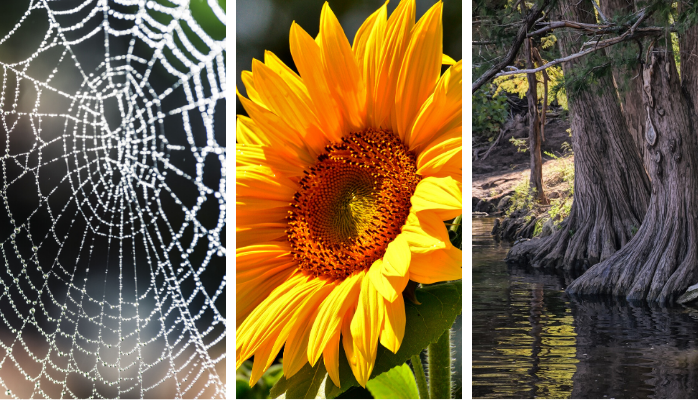
Sustainable Design Blog


What Architects Can Learn from Nature’s Design

Geometric shapes. Intricate weaves. Spider webs form strong, complex structures that function as homes and food traps for the arthropods. Sunflower florets line up at just the right angle for each to get the right amount of sunshine. Tall, majestic cypress trees don’t just look amazing. They have “knees”—woody projections growing vertically from their roots—helping them stay healthy. Nature’s designs are worth paying attention to because they present biological solutions for environmental challenges.
Nature Inspired Design: Silk, Sunflowers, and Cypress
The silk that makes up a spider’s intricate web has properties that go beyond the practical needs of spiders for home and food. Founders of Bolt Threads recognized the built-in softness, high-tensile strength, and long-lasting durability and believed they could develop natural silks that mimic the natural proteins in spider webs. The result? Bio-
designed fabric that’s as durable and biodegradable as spider’s silk.
Designers of solar arrays ran into the challenge of panels being too close together and shading one another. That meant sometimes they had to be so spread out, they’d take up enormous acreage. When researchers at the Massachusetts Institute of Technology turned to nature for a solution, they realized if they mimicked the geometric positioning of a sunflower’s florets when they laid out the solar array, the problems went away. They could use less space, gain energy efficiency, and operate with better land management.
Less understood than spider’s silk or a sunflower’s florets, cypress knees—as I’ve discussed in a previous article—act as filters to break down waste into fertilizer and then convey nutrition to the rest of the tree. One reason this matters is the need for productive ecosystem solutions in built environments. We can study nature’s design in cypress knees and develop products that work like the trees to filter waste. It could be a flat disk at the bottom of a pond that filters heavy metals or a 1,000-gallon tank with bio-filters. The better we understand nature’s solutions, the better our designed solutions will become.
Bio-design in Built Environments
Built environments have faced sustainability challenges since we started relying on concrete and steel. A massive carbon footprint comes with those industries’ energy-intensive supply chains that burn fossil fuels and use excessive amounts of water.
To overcome these challenges, architects can take lessons from nature. When we’re working on a new design, that means asking, “How is this process accomplished in nature?”
For example, we’re studying the luciferin gene in fireflies. When the substance combines with oxygen and amino acids, it produces the light we see, (light that produces no heat) when fireflies fill up the night sky.The more we understand their lights, the more potential for developing rural lighting solutions that don't rely on cables. We could actually have nature inspired design that gives us greater security in rural areas.
We're also studying the calcium carbonate in conch shells and considering how to design and build sea walls with it. Calcium carbonate forms when conch shells and other sea animals pull carbonate from the ocean’s saltwater to combine it with their own calcium. The idea behind building sea walls with calcium carbonate is the saltwater will naturally help build the wall. We don’t have all the pieces to the puzzle yet, but if successful, a sea wall like this would be a carbon sink. Another biodesign that solves an environmental challenge.
Everyday lessons from nature are numberless, and designing more sustainable built environments depends on our ability to learn them well.
To find out more about how we look to nature’s design in our green architectural design services, reach out.

How this year's presidential election may impact climate change

How green is your favorite candidate?
This year's election is proving to be quite the dramatic showdown. Trump just all but sealed the Republican nomination, and Sanders and Clinton are brawling for every last delegate on the table.
There are a lot of hot button issues too - from building walls across national borders (what an architectural feat that would be), to freedom of religious expression, to our economy, to the dichotomy of lower income earners and the top 1%
But let's not also forget about the climate. Yes, this too has been somewhat of a contentious debate, and the outcome may reshape everything we know about our future, since the President will be leading policy change and very likely decided 4 new Supreme Court Justices if they make it two terms.
That's a pretty big deal for us greenies... and anybody who enjoys living on this rock we call Earth.
So, what do they think about when it comes to the environment?:
I wrote this a few days ago, by the way, before Kasich and Cruz dropped out, but their stances are still very meaningful, and they still hold office.
1. Hillary: the US must act
We'll start with Hillary. She has a commanding lead, and she and Bernie believe in a lot of the same things when it comes to climate change. So, what is she saying about it?
“The science of climate change is unforgiving, no matter what the deniers may say; sea levels are rising, ice caps are melting, storms, droughts and wildfires are wreaking havoc.” - Hillary Clinton, Remarks to the League of Conservation Voters in New York, November 13, 2015
“For this generation of Americans, climate change is our Space Race. It is our home-front mobilization during World War II and it is our response to the Great Depression.” - Hillary Clinton November 4, 2007.
2. Bernie: The US must act
Bernie is no stranger to climate change politics either.
“Today, the scientific community is virtually unanimous: climate change is real, it is caused by human activity, and we have a moral responsibility to transform our energy system away from fossil fuel to energy efficiency and sustainable energy.” - Bernie Sanders, Democratic Presidential Debate, October 13, 2015
“...the greatest global crisis that we face,” - Bernie Sanders
(MORE LIKE THIS: Evaluating the US/China Climate deal)
3. Cruz: It's a myth
“The scientific evidence doesn't support global warming... The satellites that actually measure the temperature showed no significant warming whatsoever ... Climate change is the perfect pseudoscientific theory for a big government politician who wants more power. Why? Because it is a theory that can never be disproven.” - Ted Cruz, NPR interview, December 9, 2015
“Climate change is not science, it's religion,” Ted Cruz, Glenn Beck interview October 2015.
4. Trump: IT'S A MYTH
“Snowing in Texas and Louisiana, record setting freezing temperatures throughout the country and beyond. Global warming is an expensive hoax!” Donald Trump, Tweet, January 29, 2014
“I don’t believe in climate change,” Donald Trump, CNN interview. September 2015
5. Kasich: Well...
“I think that human beings do affect the climate... We have to take our time to have remedies.” - John Kasich, NPR Living On Earth program, January 24, 2016
“We are going to continue to work on cleaning coal, but I want to tell you, we are going to dig it, we are going to clean it, and we are going to burn it in Ohio, and we are not going to apologize for it.” John Kasich, May 20, 2012
6. Nasa: science!
I realize NASA isn't running for president, but they do have an opinion on the issue that might help some of you naysayers or those on the fence about this issue...
“Multiple studies published in peer-reviewed scientific journals show that 97 percent or more of actively publishing climate scientists agree: Climate-warming trends over the past century are very likely due to human activities. In addition, most of the leading scientific organizations worldwide have issued public statements endorsing this position”
“Scientific evidence for warming of the climate system is unequivocal.”- Intergovernmental Panel on Climate Change
So at least there is clarity out there. The candidates are clear on their positions (except maybe John Kasich) and the science is clear. We can measure the level of the oceans, the temperature of the planet and carbon dioxide. We can compare it to previous data we have gathered. We can now observe the effects of our warming planet. Have we become a society that does not care what it leaves to the next generation (or the next 7 generations)?
CONCLUSION:
I often look to Neil deGrasse Tyson for perspective in the madness. You have probably heard this already. He says, “The good thing about science is that it's true whether or not you believe in it.”
Sustainable building design (get the free ebook about green home design by Carlson Studio) can a play a big part in solving the climate issues we face. Buildings use about 48% of all the energy in the US (from architecture2030.org). Transportation uses about 27%.
Energy use directly impacts CO2 emissions, given our current infrastructure that typically burns fossil fuel to create energy. As we now know, there options to create energy without CO2 emissions. Sources of energy such Hydroelectric, solar, wind, geo thermal, etc. can all help the main made environment become more sustainable. And that is just the energy part. Sustainable design, if done properly, can improve water conservation, improve human health and happiness, conserve resources and materials and have a gentle impact on the building site.
As Katherine Hayhoe told us at Green Build 2014 in New Orleans, there will be some level of adaption to climate change and some level of suffering. Our actions are coming too late to eliminate all suffering. We get to choose how much change and how much suffering us and future generations will be exposed to. http://katharinehayhoe.com/ She is also very hopeful, as am I.
What will the voters decide? What will you decide?
Interested in doing your part beyond voting? How about a free consultation about green design or LEED consulting? Our team of talented architects and eco consultants at Carlson Studio Architecture are here to help!
